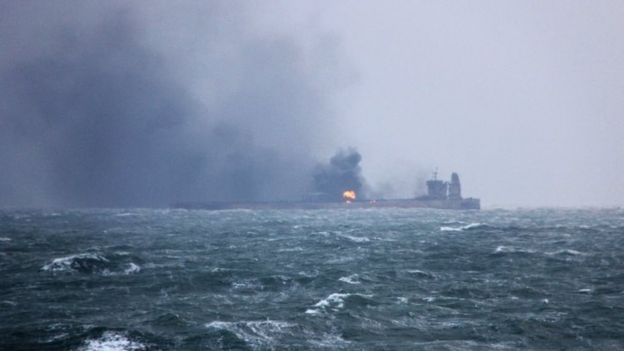
http://www.bbc.com/news/world-asia-china-42615951
No large oil spill has been detected
so far from a tanker that has been burning since Saturday evening off
the coast of China, Chinese officials say.
The Sanchi is still alight and bad weather - with waves of up to 4m (13ft) - is hampering the rescue work.
The vessel collided with a cargo ship about 260km (160 miles) off the coast of Shanghai.
Of the 30 Iranians and two Bangladeshis on the tanker, only one body has so far been found.
Twenty-one Chinese nationals on the cargo ship were rescued.
The Sanchi tanker has on board 136,000 tonnes of condensate, which is an ultra-light version of crude oil.
What are the latest developments?
China's transport ministry said heavy winds, rain and high waves continued to hamper efforts to contain the fire.
However, it added that experts at the scene believed
that, given the wave conditions, no more than 1% of the condensate was
on the surface of the water.
A formal accident investigation, involving several government departments, would start on Tuesday, officials said.
Where, how and when did the accident happen?
The collision, in the mouth of the Yangtze River Delta, occurred on Saturday evening.
The exact cause is not yet known.
What is the Sanchi carrying?
The
tanker, run by Iran's leading oil shipping operator, has on board about
one million barrels of condensate, which at current prices is worth
roughly $60m (£44m).
The Sanchi will also be carrying a certain amount of heavy - and toxic - shipping fuel.
Condensate is very different from the black crude that is often seen in oil spills.
It exists in gas form within high-pressure oil reservoirs and liquefies once extracted.
It is toxic, low in density and considerably more explosive than regular crude oil.
Condensate,
which does not need the heavy refining process of denser crude, creates
products such as jet fuel, petrol, diesel and heating fuel.
How does this compare with other oil spills?
The harm from oil pollution depends on a number of factors, not just on how much is spilled.
Location is paramount, followed by factors such as the type of oil, sea conditions, wave directions, climate and time of year.
The
Atlantic Empress incident listed below - the record spill from ships -
saw little oil reach coastlines, whereas the Exxon Valdez, which spilled
eight times less, is considered one of the world's worst environmental
disasters.
Arguably the worst spill was the deliberate release
of up to 500 million gallons by the Iraqis in January 1991 during the
Gulf War. The resultant slick covered some 10,300 sq km (4,000 sq
miles).
As far as ships are concerned:
- The Atlantic Empress and Aegean Captain collided off Trinidad and Tobago in 1979. The Atlantic Empress exploded and 26 crew members died. The 90 million gallon oil spill is a record from ships
- The ABT Summer exploded off Angola in 1991, spilling about 80 million gallons over 200 sq km
- The Castillo de Bellver caught fire and broke apart off Cape Town, spilling 78 million gallons
- The Amoco Cadiz spilled almost 69 million gallons after running aground off Brittany in France in 1978
- The Torrey Canyon hit a reef off Cornwall, England, in 1967, spilling 36 million gallons of crude and affecting almost 200 miles of coastline
- The Exxon Valdez only spilled 11 million gallons in Prince William Sound, Alaska, in 1989 but was a major environmental disaster
No comments:
Post a Comment